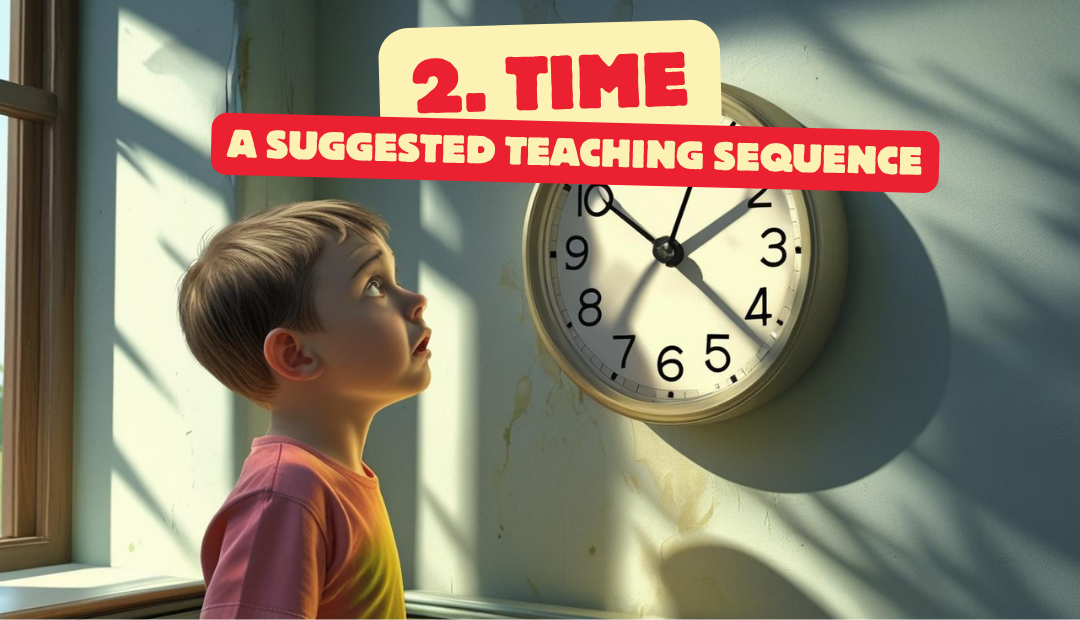This blog suggests a sequence of steps that provide the necessary foundation for learning to tell the time on an analogue clock. The steps are multisensory. That is, the learner is doing, talking and seeing throughout. This is an essential component for learners to experience. Showing pictures or simply demonstrating yourself will be a waste of time (pun intended). To learn why, read my blog about why learning to tell the time is so challenging.
You will need:
- Wooden numbers
- Light card for number lines
- Coloured pencils/felt tips
- Three geared clocks (like these). One with just the hour hand on, one with just the minute hand and one in its original state.
- An hour hand and a minute hand (save the ones removed from the geared clocks if possible)
- Check and reinforce familiarity with the numerals 1 – 12. Use wooden numbers – can they be named? Can they be ordered?
- Count in 1s.
- Count in 5s.
- Start with a number line from 1 – 12. Recite: 1 hour, 2 hours, 3 hours … . Have an ‘hour hand’ held in the learner’s hand to move along the number line.
- Once secure, add differently-coloured, smaller increments of 5 underneath each of the larger numerals. Recite: 5 minutes, 10 minutes, 15 minutes … . Have a ‘minute hand’ held in the learner’s hand to move along the number line. This will be longer and a different colour to the hour hand.
- Once confident, physically join the ends of the number line together. Have the learner transfer the numbers on the number line to a flat surface, so that the ‘line’ is now a ‘circle’ (like a clock face). Repeat the counting in 1s and 5s around the new representation until mastered.
- Fold the same or a new duplicate number line into four equal parts. Identify the quarters and halves. This uses an area model, but you can also identify that one quarter (of 12) is 3 and one half is 6.
- Transpose the fractions of the number line onto the clockface. Note that the quarters are still at 3 (6) and 9, and that the half is at 6. Reinforce by folding the circle into quarters. Colour clocks in to show the different fractions.
- Note the direction that the hands turn on the clock. Explain we call this ‘clockwise’. (No need to confuse things with introducing ‘anticlockwise’ at this point).
- Using only an hour hand (the same one that was used to move along the number line, if possible), have the learner move the hour hand and recite: 1 hour, 2 hours, 3 hours … .
- Once confident, note when the hour hand is ‘half way’ between two numbers. Add quarter past the hour / quarter to (if you feel this is appropriate, but you may wish to just note half past for now).
- Remove the hour hand and repeat with the minute hand. Note the clockwise movement again. Recite: 5 minutes, 10 minutes, 15 minutes … .
- Once confident, note when the minute hand is ‘half way’ around the clock face. Make explicit links with the coloured fractions of the clockface created earlier.
- Only when the learner has mastered counting in hours and minutes, put both hands onto the clock. Ask the learner to see what they notice (any answer is acceptable – praise all observations). Ask, “What happens when the minute hand has made one whole rotation?” (Model this so they understand the term ‘rotation’ and use ‘whole’ to maintain fractions vocabulary). Encourage the learner to see that 60 minutes is equivalent to 1 hour.
- Repeat, encouraging the learner to note where the hour hand is when the minute hand is half way around. Note that the hour hand is half way between the two hour hands.
Note that all of the above is carried out before the learner begins to use terms such as ‘o’clock’, ‘half past’, ‘quarter past/to’. It provides a conceptual understanding of all the underpinning elements of telling the time with an analogue clock. Without this structured foundation, trying to learn how to tell the time is fruitless.
Once the above foundations have been laid, it will be possible to teach the conventions for reading an analogue clock. It is likely that you will be able to then teach the steps as suggested in the national curriculum or your school’s scheme. Remember, lots of overlearning, talking and doing are essential for your learner, and may take longer than you might expect to securely learn each year group’s objectives – so take it at your learner’s own pace.
Remember time anxiety is real for many neurodivergent learners so it is important to build in:
Flexibility: Allow a buffer between activities.
Reassurance: Regular check-ins about what’s happening now and next.
Positive framing: Praise effort in using time tools, not just accuracy.
Read my third blog in this series on practical strategies for telling the time.


Leave a Reply